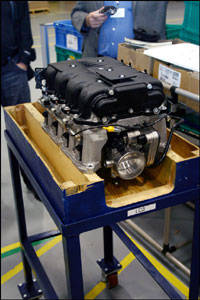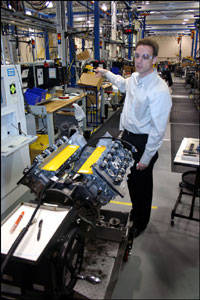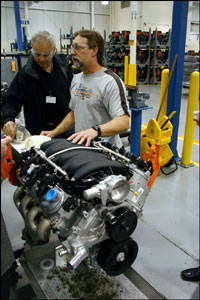Of
course, the LS7's displacement is almost 2 gallons (7008 cc, 427.6 cu-in), so that's enough to explain the booming echo and explosive sounds from the hot test room, which speak of its character in a very loud, emphatic manner. The slightly more modern and tech heavy LC3 stars a big, black box supercharger that sits right atop the intake and exhaust valves, controlled by dual overhead cams linked to a tangle of timing chains and fuel injection. If not for the slick engine cover in the bay of the STS-V, it would be one messy looking engine with wires and plugs sticking out all over the place like some sort of Frankensteinian contraption. In the end, the LC3 makes 443 hp and 469 hp in the XLR-V and STS-V respectively, and as with all V cars, 0-100 km/h acceleration is under 5 seconds.
But to tell you the truth, those two engines aren't really the stars of the show. Here at the Performance Build Center in Wixom, Michigan, the Builders are the stars. The Builders are masters of their craft, some with more experience building engines than I have walking. Barry Dennis, one such Master Builder that I mentioned earlier (the one with over 26 years assembly experience), accompanied us on our tour of the facility, highlighting its capabilities and demonstrating the standard of perfection to which its employees try to adhere. No squeaky timing chains will ever leave this building, or any imperfectly torqued bolts and I'm guessing none of the parts are free to leave as in Johnny Cash's famed ballad, "One Piece at a Time."
The
entire process starts off with Dunnage. Dunnage is apparently a technical term for boxes, crates or packaging. See, even the names for simple things are sophisticated here. Now that's boutique. Engine components arrive and are held over in the 'supermarket' (okay, some terms aren't so fancy), where builders can come and 'shop' for their next parts. Most major parts are distributed to a series of workstations arranged in 3 separate lines, two for the LS7 and one for the LC3. Many of the workers on each line can work on either line, a necessary adaptability in such a small workforce to keep everything balanced. The day starts with a trip to the dishwasher for the engine block, where it is rinsed in a gentle soapy solution that you wouldn't be afraid to wash your baby in--just kidding, it's actually really hot, and it's apparently not recommended that you wash babies in it.
Anyhow, at that point a builder such as Barry will get his block,
mount it in its cradle on a trolley and handcuff himself to it until every last piece, part and nut is attached perfectly. Only then does his supervisor give him his key so he can go home. Okay, I'm being silly again, while builders don't have to stay on until they finish their engine at the end of the day, once they have a block, they assemble it from the placement of the first camshaft to the final check of the 340 or so torque tests on each nut and bolt holding the thing together. Anything goes wrong, you know who to talk to. Not only that, but if anything goes wrong, it never leaves the floor.
 |
| That's not an engine, that's just the supercharger and header assembly. (Photo: Jonathan Yarkony, Canadian Auto Press) |
But to tell you the truth, those two engines aren't really the stars of the show. Here at the Performance Build Center in Wixom, Michigan, the Builders are the stars. The Builders are masters of their craft, some with more experience building engines than I have walking. Barry Dennis, one such Master Builder that I mentioned earlier (the one with over 26 years assembly experience), accompanied us on our tour of the facility, highlighting its capabilities and demonstrating the standard of perfection to which its employees try to adhere. No squeaky timing chains will ever leave this building, or any imperfectly torqued bolts and I'm guessing none of the parts are free to leave as in Johnny Cash's famed ballad, "One Piece at a Time."
The
 |
| Jeffrey Stafford shows us the station where the LC3's complex timing chain assembly is tested and approved. (Photo: Jonathan Yarkony, Canadian Auto Press) |
Anyhow, at that point a builder such as Barry will get his block,
 |
| Barry Dennis explains the procedure for retrofitting an aborted LS7 that has not passed its "Hot Test". (Photo: Jonathan Yarkony, Canadian Auto Press) |


